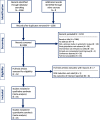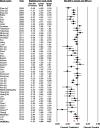Regenerative cell therapy for pulmonary arterial hypertension in animal models: a systematic review
- PMID: 30841915
- PMCID: PMC6404277
- DOI: 10.1186/s13287-019-1172-6
Regenerative cell therapy for pulmonary arterial hypertension in animal models: a systematic review
Abstract
Background: Pulmonary arterial hypertension (PAH) is a rare disease characterized by widespread loss of the pulmonary microcirculation and elevated pulmonary arterial pressures leading to pathological right ventricular remodeling and ultimately right heart failure. Regenerative cell therapies could potentially restore the effective lung microcirculation and provide a curative therapy for PAH. The objective of this systematic review was to compare the efficacy of regenerative cell therapies in preclinical models of PAH.
Methods: A systematic search strategy was developed and executed. We included preclinical animal studies using regenerative cell therapy in experimental models of PAH. Primary outcomes were right ventricular systolic pressure (RVSP) and mean pulmonary arterial pressure (mPAP). The secondary outcome was right ventricle/left ventricle + septum weight ratio (RV/LV+S). Pooled effect sizes were undertaken using random effects inverse variance models. Risk of bias and publication bias were assessed.
Results: The systematic search yielded 1285 studies, of which 44 met eligibility criteria. Treatment with regenerative cell therapy was associated with decreased RVSP (SMD - 2.10; 95% CI - 2.59 to - 1.60), mPAP (SMD - 2.16; 95% CI - 2.97 to - 1.35), and RV/LV+S (SMD - 1.31, 95% CI - 1.64 to - 0.97). Subgroup analysis demonstrated that cell modification resulted in greater reduction in RVSP. The effects on RVSP and mPAP remained statistically significant even after adjustment for publication bias. The majority of studies had an unclear risk of bias.
Conclusions: Preclinical studies of regenerative cell therapy demonstrated efficacy in animal models of PAH; however, future studies should consider incorporating design elements to reduce the risk of bias.
Systematic review registration: Suen CM, Zhai A, Lalu MM, Welsh C, Levac BM, Fergusson D, McIntyre L and Stewart DJ. Efficacy and safety of regenerative cell therapy for pulmonary arterial hypertension in animal models: a preclinical systematic review protocol. Syst Rev. 2016;5:89.
Trial registration: CAMARADES-NC3Rs Preclinical Systematic Review & Meta-analysis Facility (SyRF). http://syrf.org.uk/protocols/ . Syst Rev 5:89, 2016.
Keywords: Animal models of human disease; Cell therapy; Meta-analysis; Pulmonary hypertension.
Conflict of interest statement
Ethics approval and consent to participate
N/A.
Consent for publication
N/A.
Competing interests
DS is an unpaid consultant and has an equity interest in Northern Therapeutics (Montréal, QC, Canada). The other authors declare that they have no competing interests.
Publisher’s Note
Springer Nature remains neutral with regard to jurisdictional claims in published maps and institutional affiliations.
Figures





References
-
- Simonneau G, Gatzoulis MA, Adatia I, Celermajer D, Denton C, Ghofrani A, et al. Updated clinical classification of pulmonary hypertension. J Am Coll Cardiol. 2013;62(25 Suppl):D34–D41. - PubMed
-
- McLaughlin VV, Archer SL, Badesch DB, Barst RJ, Farber HW, Lindner JR, et al. ACCF/AHA 2009 expert consensus document on pulmonary hypertension: a report of the American College of Cardiology Foundation Task Force on Expert Consensus Documents and the American Heart Association: developed in collaboration with the American College of Chest Physicians, American Thoracic Society, Inc., and the Pulmonary Hypertension Association. Circulation. 2009;119(16):2250–2294. - PubMed
-
- Jurasz P, Courtman D, Babaie S, Stewart DJ. Role of apoptosis in pulmonary hypertension: from experimental models to clinical trials. Pharmacol Ther. 2010;126(1):1–8. - PubMed
-
- Humbert M, Morrell NW, Archer SL, Stenmark KR, MacLean MR, Lang IM, et al. Cellular and molecular pathobiology of pulmonary arterial hypertension. J Am Coll Cardiol. 2004;43(12 Suppl S):13S–24S. - PubMed
Publication types
MeSH terms
LinkOut - more resources
Full Text Sources
Medical
Miscellaneous

